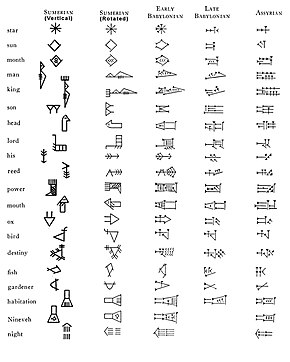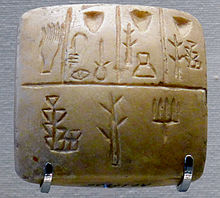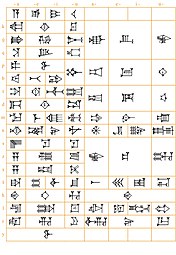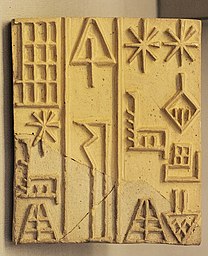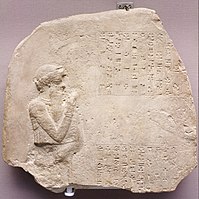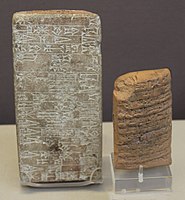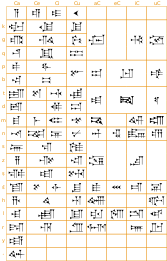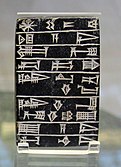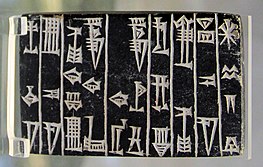Cuneiform
| Cuneiform Sumero-Akkadian cuneiform | |
|---|---|
 Trilingual cuneiform inscription of Xerxes I at Van Fortress in Turkey, written in Old Persian, Akkadian and Elamite | |
| Type | Logographic and syllabary
|
| Languages | Akkadian, Eblaite, Elamite, Hattic, Hittite, Hurrian, Luwian, Sumerian, Urartian, Old Persian |
| Created | around 3200 BC[1] |
Time period | c. 31st century BC to 2nd century AD |
Parent systems | (Proto-writing)
|
Child systems | None; influenced shape of Ugaritic; apparently inspired Old Persian |
| Direction | Left-to-right |
| ISO 15924 | Xsux, 020 |
Unicode alias | Cuneiform |
| |
Cuneiform, or Sumero-Akkadian cuneiform,[a] was one of the earliest systems of writing, invented by Sumerians in ancient Mesopotamia.[b][4][5] It is distinguished by its wedge-shaped marks on clay tablets, made by means of a blunt reed for a stylus.[6][7][8][9] The term cuneiform comes from cuneus, Latin for "wedge".[10][11][12]
Emerging in Sumer in the late fourth millennium BC (the Uruk IV period) to convey the Sumerian language, which was a language isolate, cuneiform writing began as a system of pictograms, stemming from an earlier system of shaped tokens used for accounting. In the third millennium, the pictorial representations became simplified and more abstract as the number of characters in use grew smaller (Hittite cuneiform). The system consists of a combination of logophonetic, consonantal alphabetic, and syllabic signs.
The original Sumerian script was adapted for the writing of the Semitic Akkadian (Assyrian/Babylonian), Eblaite and Amorite languages, the language isolates Elamite, Hattic, Hurrian and Urartian, as well as Indo-European languages Hittite and Luwian; it inspired the later Semitic Ugaritic alphabet as well as Old Persian cuneiform. Cuneiform writing was gradually replaced by the Phoenician alphabet during the Neo-Assyrian Empire (911–612 BC). By the second century AD, the script had become extinct, its last traces being found in Assyria and Babylonia, and all knowledge of how to read it was lost until it began to be deciphered in the 19th century.
Geoffrey Sampson stated that Egyptian hieroglyphs "came into existence a little after Sumerian script, and, probably, [were] invented under the influence of the latter",[13] and that it is "probable that the general idea of expressing words of a language in writing was brought to Egypt from Sumerian Mesopotamia".[14][15] There are many instances of Egypt-Mesopotamia relations at the time of the invention of writing, and standard reconstructions of the development of writing generally place the development of the Sumerian proto-cuneiform script before the development of Egyptian hieroglyphs, with the suggestion the former influenced the latter.[16]
Between half a million[17] and two million cuneiform tablets are estimated to have been excavated in modern times, of which only approximately 30,000[18]–100,000 have been read or published. The British Museum holds the largest collection (c. 130,000), followed by the Vorderasiatisches Museum Berlin, the Louvre, the Istanbul Archaeology Museums, the National Museum of Iraq, the Yale Babylonian Collection (c. 40,000), and Penn Museum. Most of these have "lain in these collections for a century without being translated, studied or published",[17] as there are only a few hundred qualified cuneiformists in the world.[18]
History[edit]
The origins of writing appear during the start at of the pottery-phase of the Neolithic, when clay tokens were used to record specific amounts of livestock or commodities.[21] These tokens were initially impressed on the surface of round clay envelopes and then stored in them.[21] The tokens were then progressively replaced by flat tablets, on which signs were recorded with a stylus. Actual writing is first recorded in Uruk, at the end of the 4th millennium BC, and soon after in various parts of the Near-East.[21]
An ancient Mesopotamian poem gives the first known story of the invention of writing:
Because the messenger's mouth was heavy and he couldn't repeat [the message], the Lord of Kulaba patted some clay and put words on it, like a tablet. Until then, there had been no putting words on clay.
The cuneiform writing system was in use for more than three millennia, through several stages of development, from the 31st century BC down to the second century AD.[24] Ultimately, it was completely replaced by alphabetic writing (in the general sense) in the course of the Roman era, and there are no cuneiform systems in current use. It had to be deciphered as a completely unknown writing system in 19th-century Assyriology. Successful completion of its deciphering is dated to 1857.
|
The cuneiform script underwent considerable changes over a period of more than two millennia. The image below shows the development of the sign SAĜ "head" (Borger nr. 184, U+12295 𒊕). Stages:
|
Pictographic and proto-cuneiform characters (circa 3500 BC)[edit]
The cuneiform script was developed from pictographic proto-writing in the late 4th millennium BC, stemming from the near eastern token system used for accounting. These tokens were in use from the 9th millennium BC and remained in occasional use even late in the 2nd millennium BC.[26] Early tokens with pictographic shapes of animals, associated with numbers, were discovered in Tell Brak, and date to the mid-4th millennium BC.[27] It has been suggested that the token shapes were the original basis for some of the Sumerian pictographs.[28]
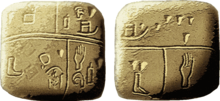
Mesopotamia's "proto-literate" period spans roughly the 35th to 32nd centuries BC. The first unequivocal written documents start with the Uruk IV period, from circa 3,300 BC, followed by tablets found in Uruk III, Jemdet Nasr and Susa (in Proto-Elamite) dating to the period until circa 2,900 BC.[29] Originally, pictographs were either drawn on clay tablets in vertical columns with a sharpened reed stylus or incised in stone. This early style lacked the characteristic wedge shape of the strokes.[30]
Certain signs to indicate names of gods, countries, cities, vessels, birds, trees, etc., are known as determinatives and were the Sumerian signs of the terms in question, added as a guide for the reader. Proper names continued to be usually written in purely "logographic" fashion.
Archaic cuneiform (circa 3000 BC)[edit]
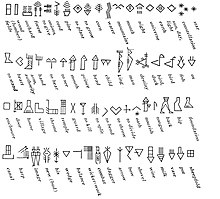
The first inscribed tablets were purely pictographic, which makes it technically impossible to know in which language they were written, but later tablets after circa 2,900 BC start to use syllabic elements, which clearly show a language structure typical of the non-Indo-European agglutinative Sumerian language.[32] The first tablets using syllabic elements date to the Early Dynastic I-II, circa 2,800 BC, and they are clearly in Sumerian.[33] This is the time when some pictographic element started to be used for their phonetical value, permitting the recording of abstract ideas or personal names.[33] Many pictographs began to lose their original function, and a given sign could have various meanings depending on context. The sign inventory was reduced from some 1,500 signs to some 600 signs, and writing became increasingly phonological. Determinative signs were re-introduced to avoid ambiguity. Cuneiform writing proper thus arises from the more primitive system of pictographs at about that time (Early Bronze Age II).
The earliest known Sumerian king, whose name appears on contemporary cuneiform tablets, is Enmebaragesi of Kish (fl. c. 2600 BC).[34] Surviving records only very gradually become less fragmentary and more complete for the following reigns, but by the end of the pre-Sargonic period, it had become standard practice for each major city-state to date documents by year-names commemorating the exploits of its lugal (king).
Proto-cuneiform tablet, Jemdet Nasr period, c. 3100–2900 BC.
Proto-cuneiform tablet, Jemdet Nasr period, c. 3100–2900 BC. A dog on a leash is visible in the background of the lower panel.[35]
The Blau Monuments combine proto-cuneiform characters and illustrations, 3100–2700 BC. British Museum.
Early Dynastic cuneiform (circa 2500 BC)[edit]
Early cuneiform inscription used simple linear inscriptions, made by using a pointed stylus, sometimes called "linear cuneiform", before the introduction of new wedge-type styluses with their typical wedge-shaped signs.[36] Many of the early dynastic inscriptions, particularly those made on stone continued to use the linear style as late as circa 2000 BCE.[36]
In the mid-3rd millennium BC, a new wedge-tipped stylus was introduced which was pushed into the clay, producing wedge-shaped ("cuneiform") signs; the development made writing quicker and easier, especially when writing on soft clay.[36] By adjusting the relative position of the stylus to the tablet, the writer could use a single tool to make a variety of impressions.[36] For numbers, a round-tipped stylus was initially used, until the wedge-tipped stylus was generalized.[36] The direction of writing remained to be from top-to-bottom and right-to-left, until the mid-2nd millennium BC.[36] Cuneiform clay tablets could be fired in kilns to bake them hard, and so provide a permanent record, or they could be left moist and recycled if permanence was not needed. Many of the clay tablets found by archaeologists have been preserved by chance, baked when attacking armies burned the buildings in which they were kept.[36]
The script was also widely used on commemorative stelae and carved reliefs to record the achievements of the ruler in whose honor the monument had been erected. The spoken language included many homophones and near-homophones, and in the beginning, similar-sounding words such as "life" [til] and "arrow" [ti] were written with the same symbol. After the Semites conquered Southern Mesopotamia, some signs gradually changed from being pictograms to syllabograms, most likely to make things clearer in writing. In that way, the sign for the word "arrow" would become the sign for the sound "ti".
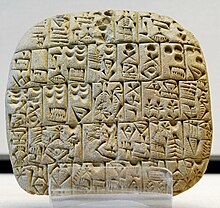
Words that sounded alike would have different signs; for instance, the syllable [ɡu] had fourteen different symbols. When the words had a similar meaning but very different sounds they were written with the same symbol. For instance 'tooth' [zu], 'mouth' [ka] and 'voice' [gu] were all written with the symbol for "voice". To be more accurate, scribes started adding to signs or combining two signs to define the meaning. They used either geometrical patterns or another cuneiform sign.
As time went by, the cuneiform got very complex and the distinction between a pictogram and syllabogram became vague. Several symbols had too many meanings to permit clarity. Therefore, symbols were put together to indicate both the sound and the meaning of a compound. The word 'raven' [UGA] had the same logogram as the word 'soap' [NAGA], the name of a city [EREŠ], and the patron goddess of Eresh [NISABA]. Two phonetic complements were used to define the word [u] in front of the symbol and [gu] behind. Finally, the symbol for 'bird' [MUŠEN] was added to ensure proper interpretation.[clarification needed]
For unknown reasons, cuneiform pictographs, until then written vertically, were rotated 90° to the left, in effect putting them on their side. This change first occurred slightly before the Akkadian period, at the time of the Uruk ruler Lugalzagesi (r. c. 2294–2270 BC).[37][36] The vertical style remained for monumental purposes on stone stelas until the middle of the 2nd millennium.[36]
Written Sumerian was used as a scribal language until the first century AD. The spoken language died out between about 2100 and 1700 BC.
Sumero-Akkadian cuneiform[edit]
(circa 2200 BC)
The archaic cuneiform script was adopted by the Akkadian Empire from the 23rd century BC (short chronology). The Akkadian language being Semitic, its structure was completely different from Sumerian.[41] There was no way to use the Sumerian writing system as such, and the Akkadians found a practical solution in writing their language phonetically, using the corresponding Sumerian phonetic signs.[41] Still, some of the Sumerian characters were retained for their pictorial value as well: for example the character for "sheep" was retained, but was now pronounced immerū, rather then the Sumerian "udu-meš".[41]
The Semitic languages employed equivalents for many signs that were distorted or abbreviated to represent new values because the syllabic nature of the script as refined by the Sumerians was not intuitive to Semitic speakers.[41] From the beginning of the Middle Bronze Age (20th century BC), the script evolved to accommodate the various dialects of Akkadian: Old Akkadian, Babylonian and Assyrian.[41] In particular, the Old Assyrian cuneiform employed many modifications to Sumerian orthography. At this stage, the former pictograms were reduced to a high level of abstraction, and were composed of only five basic wedge shapes: horizontal, vertical, two diagonals and the Winkelhaken impressed vertically by the tip of the stylus. The signs exemplary of these basic wedges are:
- AŠ (B001, U+12038) 𒀸: horizontal;
- DIŠ (B748, U+12079) 𒁹: vertical;
- GE23, DIŠ tenû (B575, U+12039) 𒀹: downward diagonal;
- GE22 (B647, U+1203A) 𒀺: upward diagonal;
- U (B661, U+1230B) 𒌋: the Winkelhaken.
Except for the Winkelhaken which has no tail, the length of the wedges' tails could vary as required for sign composition.
Signs tilted by about 45 degrees are called tenû in Akkadian, thus DIŠ is a vertical wedge and DIŠ tenû a diagonal one. If a sign is modified with additional wedges, this is called gunû or "gunification"; if signs are cross-hatched with additional Winkelhaken, they are called šešig; if signs are modified by the removal of a wedge or wedges, they are called nutillu.
"Typical" signs have about five to ten wedges, while complex ligatures can consist of twenty or more (although it is not always clear if a ligature should be considered a single sign or two collated, but distinct signs); the ligature KAxGUR7 consists of 31 strokes.
Most later adaptations of Sumerian cuneiform preserved at least some aspects of the Sumerian script. Written Akkadian included phonetic symbols from the Sumerian syllabary, together with logograms that were read as whole words. Many signs in the script were polyvalent, having both a syllabic and logographic meaning. The complexity of the system bears a resemblance to Old Japanese, written in a Chinese-derived script, where some of these Sinograms were used as logograms and others as phonetic characters.
Assyrian cuneiform[edit]
(circa 650 BC)
This "mixed" method of writing continued through the end of the Babylonian and Assyrian empires, although there were periods when "purism" was in fashion and there was a more marked tendency to spell out the words laboriously, in preference to using signs with a phonetic complement. Yet even in those days, the Babylonian syllabary remained a mixture of logographic and phonemic writing.
Hittite cuneiform is an adaptation of the Old Assyrian cuneiform of c. 1800 BC to the Hittite language. When the cuneiform script was adapted to writing Hittite, a layer of Akkadian logographic spellings was added to the script, thus the pronunciations of many Hittite words which were conventionally written by logograms are now unknown.
In the Iron Age (c. 10th to 6th centuries BC), Assyrian cuneiform was further simplified. From the 6th century, the Akkadian language was marginalized by Aramaic, written in the Aramaean alphabet, but Neo-Assyrian cuneiform remained in use in the literary tradition well into the times of the Parthian Empire (250 BC–226 AD). The last known cuneiform inscription, an astronomical text, was written in 75 AD.[43] The ability to read cuneiform may have persisted until the third century AD.[44][45]
Derived scripts[edit]
Old Persian cuneiform (5th century BCE)[edit]
(circa 500 BC)
The complexity of the system prompted the development of a number of simplified versions of the script. Old Persian was written in a subset of simplified cuneiform characters known today as Old Persian cuneiform, developed by Darius the Great in the 5th century BC. It formed a semi-alphabetic syllabary, using far fewer wedge strokes than Assyrian used, together with a handful of logograms for frequently occurring words like "god" (𐏎), "king" (𐏋) or "country" (𐏌). This almost purely alphabetical form of the cuneiform script (36 phonetic characters and 8 logograms), was specially designed and used by the early Achaemenid rulers from the 6th century BC.[46]
Ugaritic[edit]
Ugaritic was written using the Ugaritic alphabet, a standard Semitic style alphabet (an abjad) written using the cuneiform method.
Decipherment[edit]
For centuries, travelers to Persepolis, located in Iran, had noticed carved cuneiform inscriptions and were intrigued.[47] Attempts at deciphering these Old Persian writings date back to Arabo-Persian historians of the medieval Islamic world, though these early attempts at decipherment were largely unsuccessful.[48]
In the 15th century, the Venetian Giosafat Barbaro explored ancient ruins in the Middle East and came back with news of a very odd writing he had found carved on the stones in the temples of Shiraz and on many clay tablets.
Antonio de Gouvea, a professor of theology, noted in 1602 the strange writing he had had occasion to observe during his travels a year earlier in Persia which took in visits to ruins.[49][50][51] In 1625, the Roman traveler Pietro Della Valle, who had sojourned in Mesopotamia between 1616 and 1621, brought to Europe copies of characters he had seen in Persepolis and inscribed bricks from Ur and the ruins of Babylon.[52][53] The copies he made, the first that reached circulation within Europe, were not quite accurate but Della Valle understood that the writing had to be read from left to right, following the direction of wedges, but did not attempt to decipher the scripts.[54]
Englishman Sir Thomas Herbert, in the 1638 edition of his travel book Some Yeares Travels into Africa & Asia the Great, reported seeing at Persepolis carved on the wall "a dozen lines of strange characters...consisting of figures, obelisk, triangular, and pyramidal" and thought they resembled Greek.[55] In the 1677 edition he reproduced some and thought they were 'legible and intelligible' and therefore decipherable. He also guessed, correctly, that they represented not letters or hieroglyphics but words and syllables, and were to be read from left to right.[56] Herbert is rarely mentioned in standard histories of the decipherment of cuneiform.

Carsten Niebuhr brought the first reasonably complete and accurate copies of the inscriptions at Persepolis to Europe in 1767.[58][47]:9 Bishop Friedrich Münter of Copenhagen discovered that the words in the Persian inscriptions were divided from one another by an oblique wedge and that the monuments must belong to the age of Cyrus and his successors. One word, which occurs without any variation towards the beginning of each inscription, he correctly inferred to signify "king".[59][47]:10
By 1802 Georg Friedrich Grotefend had determined that two kings' names mentioned were Darius and Xerxes (but in their native Old Persian forms, which were unknown at the time and therefore had to be conjectured), and had been able to assign correct alphabetic values to the cuneiform characters which composed the two names.[60] Although Grotefend's Memoir was presented to the Göttingen Academy of Sciences and Humanities on September 4, 1802, the Academy refused to publish it; it was subsequently published in Heeren's work in 1815, but was overlooked by most researchers at the time.[61][62] It was only in 1823 that Grotefend's discovery was confirmed, when the French archaeologist Champollion, who had just deciphered Egyptian hieroglyphs, was able to read the Egytian dedication of a bilingual hieroglyph-cuneiform inscription on an alabaster vase in the Cabinet des Médailles.[57][63] The Egyptian inscription on the vase was in the name of King Xerxes I, and Champollion, together with the orientalist Abbé Saint-Martin, was able to confirm that the corresponding words in the cuneiform script were indeed the words which Grotefend had identified as meaning "king" and "Xerxes" through guesswork.[57][63]
In 1836, the eminent French scholar Eugène Burnouf discovered that the first of the inscriptions published by Niebuhr contained a list of the satrapies of Darius. With this clue in his hand, he identified and published an alphabet of thirty letters, most of which he had correctly deciphered.[47]:14[64][65]
A month earlier, a friend and pupil of Burnouf's, Professor Christian Lassen of Bonn, had also published his own work on The Old Persian Cuneiform Inscriptions of Persepolis.[65][66] He and Burnouf had been in frequent correspondence, and his claim to have independently detected the names of the satrapies, and thereby to have fixed the values of the Persian characters, was consequently fiercely attacked. According to Sayce, whatever his obligations to Burnouf may have been, Lassen's
...contributions to the decipherment of the inscriptions were numerous and important. He succeeded in fixing the true values of nearly all the letters in the Persian alphabet, in translating the texts, and in proving that the language of them was not Zend, but stood to both Zend and Sanskrit in the relation of a sister.
— Sayce[47]:15
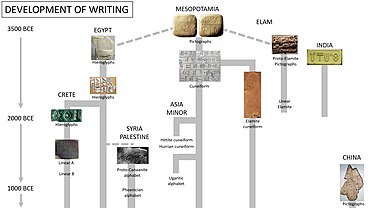
Meanwhile, in 1835 Henry Rawlinson, a British East India Company army officer, visited the Behistun Inscriptions in Persia. Carved in the reign of King Darius of Persia (522–486 BC), they consisted of identical texts in the three official languages of the empire: Old Persian, Akkadian and Elamite. The Behistun inscription was to the decipherment of cuneiform what the Rosetta Stone (discovered in 1799) was to the decipherment of Egyptian hieroglyphs in 1822.[68]
Rawlinson correctly deduced that the Old Persian was a phonetic script and he successfully deciphered it. In 1837, he finished his copy of the Behistun inscription, and sent a translation of its opening paragraphs to the Royal Asiatic Society. Before his article could be published, however, the works of Lassen and Burnouf reached him, necessitating a revision of his article and the postponement of its publication. Then came other causes of delay. In 1847, the first part of the Rawlinson's Memoir was published; the second part did not appear until 1849.[69][c] The task of deciphering the Persian cuneiform texts was virtually accomplished.[47]:17
After translating the Persian, Rawlinson and, working independently of him, the Irish Assyriologist Edward Hincks, began to decipher the others. (The actual techniques used to decipher the Akkadian language have never been fully published; Hincks described how he sought the proper names already legible in the deciphered Persian while Rawlinson never said anything at all, leading some to speculate that he was secretly copying Hincks.)[70][71][72] They were greatly helped by the excavations of the French naturalist Paul Émile Botta and English traveler and diplomat Austen Henry Layard of the city of Nineveh from 1842. Among the treasures uncovered by Layard and his successor Hormuzd Rassam were, in 1849 and 1851, the remains of two libraries, now mixed up, usually called the Library of Ashurbanipal, a royal archive containing tens of thousands of baked clay tablets covered with cuneiform inscriptions.
By 1851, Hincks and Rawlinson could read 200 Babylonian signs. They were soon joined by two other decipherers: young German-born scholar Julius Oppert, and versatile British Orientalist William Henry Fox Talbot. In 1857, the four men met in London and took part in a famous experiment to test the accuracy of their decipherments. Edwin Norris, the secretary of the Royal Asiatic Society, gave each of them a copy of a recently discovered inscription from the reign of the Assyrian emperor Tiglath-Pileser I. A jury of experts was impaneled to examine the resulting translations and assess their accuracy. In all essential points, the translations produced by the four scholars were found to be in close agreement with one another. There were, of course, some slight discrepancies. The inexperienced Talbot had made a number of mistakes, and Oppert's translation contained a few doubtful passages which the jury politely ascribed to his unfamiliarity with the English language. But Hincks' and Rawlinson's versions corresponded remarkably closely in many respects. The jury declared itself satisfied, and the decipherment of Akkadian cuneiform was adjudged a fait accompli.[73]
Proper names[edit]
In the early days of cuneiform decipherment, the reading of proper names presented the greatest difficulties. However, there is now a better understanding of the principles behind the formation and the pronunciation of the thousands of names found in historical records, business documents, votive inscriptions, literary productions, and legal documents. The primary challenge was posed by the characteristic use of old Sumerian non-phonetic logograms in other languages that had different pronunciations for the same symbols. Until the exact phonetic reading of many names was determined through parallel passages or explanatory lists, scholars remained in doubt or had recourse to conjectural or provisional readings. However, in many cases, there are variant readings, the same name being written phonetically (in whole or in part) in one instance and logographically in another.
Transliteration[edit]

Cuneiform has a specific format for transliteration. Because of the script's polyvalence, transliteration requires certain choices of the transliterating scholar, who must decide in the case of each sign which of its several possible meanings is intended in the original document. For example, the sign DINGIR in a Hittite text may represent either the Hittite syllable an or may be part of an Akkadian phrase, representing the syllable il, it may be a Sumerogram, representing the original Sumerian meaning, 'god' or the determinative for a deity. In transliteration, a different rendition of the same glyph is chosen depending on its role in the present context.
Therefore, a text containing DINGIR and MU in succession could be construed to represent the words "ana", "ila", god + "a" (the accusative case ending), god + water, or a divine name "A" or Water. Someone transcribing the signs would make the decision how the signs should be read and assemble the signs as "ana", "ila", "Ila" ("god"+accusative case), etc. A transliteration of these signs, however, would separate the signs with dashes "il-a", "an-a", "DINGIR-a" or "Da". This is still easier to read than the original cuneiform, but now the reader is able to trace the sounds back to the original signs and determine if the correct decision was made on how to read them. A transliterated document thus presents the reading preferred by the transliterating scholar as well as an opportunity to reconstruct the original text.
There are differing conventions for transliterating Sumerian, Akkadian (Babylonian), and Hittite (and Luwian) cuneiform texts. One convention that sees wide use across the different fields is the use of acute and grave accents as an abbreviation for homophone disambiguation. Thus, u is equivalent to u1, the first glyph expressing phonetic u. An acute accent, ú, is equivalent to the second, u2, and a grave accent ù to the third, u3 glyph in the series (while the sequence of numbering is conventional but essentially arbitrary and subject to the history of decipherment). In Sumerian transliteration, a multiplication sign 'x' is used to indicate typographic ligatures. As shown above, signs as such are represented in capital letters, while the specific reading selected in the transliteration is represented in small letters. Thus, capital letters can be used to indicate a so-called Diri compound – a sign sequence that has, in combination, a reading different from the sum of the individual constituent signs (for example, the compound IGI.A – "eye" + "water" – has the reading imhur, meaning "foam"). In a Diri compound, the individual signs are separated with dots in transliteration. Capital letters may also be used to indicate a Sumerogram (for example, KÙ.BABBAR – Sumerian for "silver" – being used with the intended Akkadian reading kaspum, "silver"), an Akkadogram, or simply a sign sequence of whose reading the editor is uncertain. Naturally, the "real" reading, if it is clear, will be presented in small letters in the transliteration: IGI.A will be rendered as imhur4.
Since the Sumerian language has only been widely known and studied by scholars for approximately a century, changes in the accepted reading of Sumerian names have occurred from time to time. Thus the name of a king of Ur, read Ur-Bau at one time, was later read as Ur-Engur, and is now read as Ur-Nammu or Ur-Namma; for Lugal-zage-si, a king of Uruk, some scholars continued to read Ungal-zaggisi; and so forth. Also, with some names of the older period, there was often uncertainty whether their bearers were Sumerians or Semites. If the former, then their names could be assumed to be read as Sumerian, while, if they were Semites, the signs for writing their names were probably to be read according to their Semitic equivalents, though occasionally Semites might be encountered bearing genuine Sumerian names. There was also doubt whether the signs composing a Semite's name represented a phonetic reading or a logographic compound. Thus, e.g. when inscriptions of a Semitic ruler of Kish, whose name was written Uru-mu-ush, were first deciphered, that name was first taken to be logographic because uru mu-ush could be read as "he founded a city" in Sumerian, and scholars accordingly retranslated it back to the original Semitic as Alu-usharshid. It was later recognized that the URU sign can also be read as rí and that the name is that of the Akkadian king Rimush.
Syllabary[edit]
The tables below show signs used for simple syllables of the form CV or VC. As used for the Sumerian language, the cuneiform script was in principle capable of distinguishing at least 16 consonants,[75][76] transliterated as
- b, d, g, g̃, ḫ, k, l, m, n, p, r, ř, s, š, t, z
as well as four vowel qualities, a, e, i, u. The Akkadian language had no use for g̃ or ř but needed to distinguish its emphatic series, q, ṣ, ṭ, adopting various "superfluous" Sumerian signs for the purpose (e.g. qe=KIN, qu=KUM, qi=KIN, ṣa=ZA, ṣe=ZÍ, ṭur=DUR etc.)[clarification needed] Hittite, as it adopted the Akkadian cuneiform, further introduced signs such as wi5=GEŠTIN.
| -a | -e | -i | -u | |
| a 𒀀, á 𒀉 |
e 𒂊, |
i 𒄿, í=IÁ 𒐊 |
u 𒌋, | |
| b- | ba 𒁀, |
be=BAD 𒁁, |
bi 𒁉, |
bu 𒁍, |
| d- | da 𒁕, dá=TA 𒋫 |
de=DI 𒁲, dé , |
di 𒁲, dí=TÍ 𒄭 |
du 𒁺, |
| g- | ga 𒂵, gá 𒂷 |
ge=GI 𒄀, |
gi 𒄀, |
gu 𒄖, |
| ḫ- | ḫa 𒄩, |
ḫe=ḪI 𒄭, ḫé=GAN 𒃶 |
ḫi 𒄭, ḫí=GAN 𒃶 |
ḫu 𒄷 |
| k- | ka 𒅗, |
ke=KI 𒆠, ké=GI 𒄀 |
ki 𒆠, kí=GI 𒄀 |
ku 𒆪, |
| l- | la 𒆷, |
le=LI 𒇷, lé=NI 𒉌 |
li 𒇷, lí=NI 𒉌 |
lu 𒇻, lú 𒇽 |
| m- | ma 𒈠, má 𒈣 |
me 𒈨, |
mi 𒈪, |
mu 𒈬, mú=SAR 𒊬 |
| n- | na 𒈾, |
ne 𒉈, né=NI 𒉌 |
ni 𒉌, ní=IM 𒉎 |
nu 𒉡, nú=NÁ 𒈿 |
| p- | pa 𒉺, pá=BA 𒐀 |
pe=PI 𒉿, pé=BI 𒁉 |
pi 𒉿, |
pu=BU 𒁍, |
| r- | ra 𒊏, rá=DU 𒁺 |
re=RI 𒊑, ré=URU 𒌷 |
ri 𒊑, rí=URU 𒌷 |
ru 𒊒, |
| s- | sa 𒊓, |
se=SI 𒋛, sé=ZI 𒍣 |
si 𒋛, sí=ZI 𒍣 |
su 𒋢, |
| š- | ša 𒊭, |
še 𒊺, šé, |
ši=IGI 𒅆, ší=SI 𒋛 |
šu 𒋗, |
| t- | ta 𒋫, tá=DA 𒁕 |
te 𒋼, té=TÍ 𒊹 |
ti 𒋾, |
tu 𒌅, |
| z- | za 𒍝, zá=NA4 𒉌𒌓 |
ze=ZI 𒍣, zé=ZÌ 𒍢 |
zi 𒍣, |
zu 𒍪, zú=KA 𒅗 |
| g̃- | g̃á=GÁ 𒂷 | g̃e26=GÁ 𒂷 | g̃i6=MI 𒈪 | g̃u10=MU 𒈬 |
| ř- | řá=DU 𒁺 | ře6=DU 𒁺 |
| a- | e- | i- | u- | |
| a 𒀀, á 𒀉 |
e 𒂊, |
i 𒄿, í=IÁ 𒐊 |
u 𒌋, | |
| -b | ab 𒀊, áb 𒀖 |
eb=IB 𒅁, éb=TUM 𒌈 |
ib 𒅁, íb=TUM 𒌈 |
ub 𒌒, úb=ŠÈ 𒂠 |
| -d | ad 𒀜, ád 𒄉 |
ed=Á 𒀉 | id=Á 𒀉, íd=A.ENGUR 𒀀𒇉 |
ud 𒌓, úd=ÁŠ 𒀾 |
| -g | ag 𒀝, ág 𒉘 |
eg=IG 𒅅, ég=E 𒂊 |
ig 𒅅, íg=E 𒂊 |
ug 𒊌 |
| -ḫ | aḫ 𒄴, áḫ=ŠEŠ 𒋀 |
eḫ=AḪ 𒄴 | iḫ=AḪ 𒄴 | uḫ=AḪ 𒄴, úḫ 𒌔 |
| -k | ak=AG 𒀝 | ek=IG 𒅅 | ik=IG 𒅅 | uk=UG 𒊌 |
| -l | al 𒀠, ál=ALAM 𒀩 |
el 𒂖, él=IL 𒅋 |
il 𒅋, íl 𒅍 |
ul 𒌌, úl=NU 𒉡 |
| -m | am 𒄠/𒂔, ám=ÁG 𒉘 |
em=IM 𒅎 | im 𒅎, ím=KAŠ4 𒁽 |
um 𒌝, úm=UD 𒌓 |
| -n | an 𒀭 | en 𒂗, én, |
in 𒅔, |
un 𒌦, |
| -p | ap=AB 𒀊 | ep=IB, ép=TUM 𒌈 |
ip=IB 𒅁, íp=TUM 𒌈 |
up=UB 𒌒, úp=ŠÈ 𒂠 |
| -r | ar 𒅈, ár=UB 𒌒 |
er=IR 𒅕 | ir 𒅕, íp=A.IGI 𒀀𒅆 |
ur 𒌨, úr 𒌫 |
| -s | as=AZ 𒊍 | es=GIŠ 𒄑, és=EŠ 𒂠 |
is=GIŠ 𒄑, ís=EŠ 𒂠 |
us=UZ, ús=UŠ 𒍑 |
| -š | aš 𒀸, áš 𒀾 |
eš 𒌍/𒐁, éš=ŠÈ 𒂠 |
iš 𒅖, íš=KASKAL 𒆜 |
uš 𒍑, |
| -t | at=AD 𒀜, át=GÍR gunû 𒄉 |
et=Á 𒀉 | it=Á 𒀉 | ut=UD 𒌓, út=ÁŠ 𒀾 |
| -z | az 𒊍 | ez=GIŠ 𒄑, éz=EŠ 𒂠 |
iz= GIŠ 𒄑, íz=IŠ 𒅖 |
uz=ŠE&HU 𒊺𒄷 |
| -g̃ | ág̃=ÁG 𒉘 | èg̃=ÁG 𒉘 | ìg̃=ÁG 𒉘 | ùg̃=UN 𒌦 |
Sign inventories[edit]
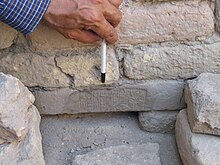
The Sumerian cuneiform script had on the order of 1,000 distinct signs (or about 1,500 if variants are included). This number was reduced to about 600 by the 24th century BC and the beginning of Akkadian records. Not all Sumerian signs are used in Akkadian texts, and not all Akkadian signs are used in Hittite.
A. Falkenstein (1936) lists 939 signs used in the earliest period (late Uruk, 34th to 31st centuries). (See #Bibliography for the works mentioned in this paragraph.) With an emphasis on Sumerian forms, Deimel (1922) lists 870 signs used in the Early Dynastic II period (28th century, Liste der archaischen Keilschriftzeichen or "LAK") and for the Early Dynastic IIIa period (26th century, Šumerisches Lexikon or "ŠL"). Rosengarten (1967) lists 468 signs used in Sumerian (pre-Sargonian) Lagash, and Mittermayer and Attinger (2006, Altbabylonische Zeichenliste der Sumerisch-Literarischen Texte or "aBZL") list 480 Sumerian forms, written in Isin-Larsa and Old Babylonian times. Regarding Akkadian forms, the standard handbook for many years was Borger (1981, Assyrisch-Babylonische Zeichenliste or "ABZ") with 598 signs used in Assyrian/Babylonian writing, recently superseded by Borger (2004, Mesopotamisches Zeichenlexikon or "MesZL") with an expansion to 907 signs, an extension of their Sumerian readings and a new numbering scheme.
Signs used in Hittite cuneiform are listed by Forrer (1922), Friedrich (1960) and Rüster and Neu (1989, Hethitisches Zeichenlexikon or "HZL"). The HZL lists a total of 375 signs, many with variants (for example, 12 variants are given for number 123 EGIR).
Numerals[edit]
The Sumerians used a numerical system based on 1, 10, and 60. The way of writing a number like 70 would be the sign for 60 and the sign for 10 right after.
Usage[edit]
(c. 2094–2047 BC)
NIN-a-ni..................... "his Lady,"
SHUL-GI.................... "Shulgi"
NITAH KALAG ga...... "the mighty man"
LUGAL URIM KI ma... "King of Ur"
LUGAL ki en............... "King of Sumer"
gi ki URI ke................. "and Akkad,"
E a ni.......................... "her Temple"
mu na DU................... "he built"[79]
Cuneiform script was used in many ways in ancient Mesopotamia. It was used to record laws, like the Code of Hammurabi. It was also used for recording maps, compiling medical manuals, and documenting religious stories and beliefs, among other uses.[80] Studies by Assyriologists like Claus Wilcke[81] and Dominique Charpin[82] suggest that cuneiform literacy was not reserved solely for the elite but was common for average citizens.
According to the Oxford Handbook of Cuneiform Culture,[83] cuneiform script was used at a variety of literacy levels: average citizens needed only a basic, functional knowledge of cuneiform script to write personal letters and business documents. More highly literate citizens put the script to more technical use, listing medicines and diagnoses and writing mathematical equations. Scholars held the highest literacy level of cuneiform and mostly focused on writing as a complex skill and an art form.
Modern usage[edit]
Cuneiform is occasionally used nowadays as inspiration for logos.
Cuneiform ama-gi, literally "return to the mother", loosely "liberty", is the logo of Liberty Fund.[84]
The central element of the GigaMesh Software Framework logo is the sign 𒆜 (kaskal) meaning "street" or "road junction", which symbolizes the intersection of the humanities and computer science.
Unicode[edit]
As of version 8.0, the following ranges are assigned to the Sumero-Akkadian Cuneiform script in the Unicode Standard:
- U+12000–U+123FF (922 assigned characters) "Cuneiform"
- U+12400–U+1247F (116 assigned characters) "Cuneiform Numbers and Punctuation"
- U+12480–U+1254F (196 assigned characters) "Early Dynastic Cuneiform"
The final proposal for Unicode encoding of the script was submitted by two cuneiform scholars working with an experienced Unicode proposal writer in June 2004.[85] The base character inventory is derived from the list of Ur III signs compiled by the Cuneiform Digital Library Initiative of UCLA based on the inventories of Miguel Civil, Rykle Borger (2003) and Robert Englund. Rather than opting for a direct ordering by glyph shape and complexity, according to the numbering of an existing catalog, the Unicode order of glyphs was based on the Latin alphabetic order of their "last" Sumerian transliteration as a practical approximation.
List of major cuneiform tablet discoveries[edit]
| Location | Number of tablets | Initial discovery | Language |
|---|---|---|---|
| Persepolis, Iran | Large[86] | 1472 | |
| Kuyunkjik hill on Tigris River, Outside of Mosul, now in Iraq | NA[citation needed] | 1840–1842 | |
| Khorsabad hill on Tigris River, Outside of Mosul, now in Iraq | Significant[citation needed] | 1843 | |
| Library of Ashurbanipal | 20,000–24,000[87] | 1849 | Akkadian |
| Nippur | 60,000[87] | 1851 | |
| Girsu | 40,000–50,000[87] | 1877 | |
| Dūr-Katlimmu | 500[87] | 1879 | |
| Sippar | Tens of thousands[87] | 1880 | Babylonian |
| Amarna letters | 382 | 1887 | Akkadian |
| Nuzi | 10,000–20,000[87] | 1896 | |
| Assur | 16,000[88] | 1898 | Akkadian |
| Hattusa | 30,000[89] | 1906 | Hittite |
| Drehem | 100,000[87] | Sumerian | |
| Kanesh | 23,000[90] | 1925[91] | Akkadian |
| Ugarit texts | 1,500 | 1929 | Ugaritic |
| Persepolis, Iran | 15,000–18,000[86] | 1933 | Elamite |
| Persepolis, Iran | 1933[86] | Old Persian | |
| Mari, Syria | 20,000–25,000[87] | 1933 | Akkadian |
| Alalakh | 300[92] | 1937 | |
| Abu Salabikh | 500[87] | 1963 | |
| Ebla tablets | c.5,000[93] | 1974 | Sumerian and Eblaite |
| Tablet V of the Epic of Gilgamesh | 1[94] | 2011 | Old Babylonian |
See also[edit]
Notes[edit]
- ^ /kjuːˈniːɪfɔːrm/ kew-NEE-i-form or /kjuːˈneɪ.ɪfɔːrm/[2][3] kew-NAY-i-form or /ˈkjuːnɪfɔːrm/[2] KEW-ni-form
- ^ Egyptian hieroglyphs date to about the same period, and it is unsettled which system began first.
- ^ It seems that various parts of Rawlisons' paper formed Vol X of this journal. The final part III comprised chapters IV (Analysis of the Persian Inscriptions of Behistunand) and V (Copies and Translations of the Persian Cuneiform Inscriptions of Persepolis, Hamadan, and Van), pp. 187–349.
References[edit]
- ^ Feldherr, Andrew; Hardy, Grant, eds. (February 17, 2011). The Oxford History of Historical Writing: Volume 1: Beginnings to AD 600. Oxford University Press. p. 5. doi:10.1093/acprof:osobl/9780199218158.001.0001. ISBN 9780199218158.
- ^ a b "Definition of cuneiform in English". Oxford Dictionaries. Archived from the original on September 25, 2016. Retrieved July 30, 2017.
- ^ Cuneiform: Irving Finkel & Jonathan Taylor bring ancient inscriptions to life. The British Museum. June 4, 2014. Archived from the original on October 17, 2015. Retrieved July 30, 2017.
- ^ Visible language : inventions of writing in the ancient Middle East and beyond. Woods, Christopher, 1968-, Emberling, Geoff., Teeter, Emily., University of Chicago. Oriental Institute. Chicago, Ill.: Oriental Institute of the University of Chicago. 2010. p. 13. ISBN 9781885923769. OCLC 664327312.CS1 maint: others (link)
- ^ Starr, Jerald Jack. "The invention and evolution of Sumerian writing". Sumerian Shakespeare. Retrieved April 30, 2019.
- ^ Cammarosano, Michele (2017–2018). "Cuneiform Writing Techniques". cuneiform.neocities.org. Retrieved July 18, 2018.CS1 maint: date format (link)
- ^ Cammarosano, Michele (2014). "The Cuneiform Stylus". Mesopotamia. XLIX: 53–90 – via https://osf.io/dfng4/.
- ^ Bramanti, Armando (2015). "The Cuneiform Stylus. Some Addenda". Cuneiform Digital Library Notes. 2015 (12).
- ^ Taylor, Jonathan. "Wedge Order in Cuneiform: a Preliminary Survey". Cite journal requires
|journal=(help) - ^ from a New Latin cuneiformis, composed of cuneus "wedge" and forma "shape" (17th century) of the script in the 19th century (Henry Creswicke Rawlinson, The Persian Cuneiform Inscription at Behistun, Decyphered and Tr.; with a Memoir on Persian Cuneiform Inscriptions in General, and on that of Behistun in Particular (1846). Different shape-derived names occur in several other languages, such as Finnish nuolenpääkirjoitus "arrowhead script", Hebrew כתב יתדות "stake script", and Persian میخی and Dutch spijkerschrift, both meaning "nail script".
- ^ The word "cuneiform" was coined in 1700 by the English orientalist Thomas Hyde (1663–1703):
- Thomas Hyde, Historia Religionis Veterum Persarum, ... [History of religion of the ancient Persians ... ] (Oxford, England: Sheldonian Theater, 1700), p. 526. [in Latin] On pages 526–527, Hyde discusses the cuneiform found at Persepolis. From p. 526: "Istiusmodi enim ductuli pyramidal seu Cuneiformes non veniunt in Gavrorum literis, nec in Telesmaticis, nec in Hieroglyphicis Ægypti; sed tales ductus (tam inter seinvicem juxta positi quam per seinvicem transmissi) sunt peculiares Persepoli ..." (Because such thin pyramidal or wedge forms do not occur in the letters of the Gavres [variously spelled Gabres, Guebers, Ghebers, or Chebers, was an old English name for Zoroastrians, an ancient cult of fire worshippers; the word Gavres was derived from the Persian word gaur for "infidel"], nor in talismans, nor in Egyptian hieroglyphs; but such drawings (so closely placed among each other as [intended to] be conveyed by means of each other) are peculiar to Persepolis, ... )
- (Meade, 1974), p. 5. Archived December 19, 2016, at the Wayback Machine
- Kaempfer, Engelbert, Amoenitatum Exoticarum ... [Of Foreign Charms ... ] (Lippe (Lemgoviae), (Germany): Heinrich Wilhelm Meyer, 1712), p. 331. On p. 331 Kaempfer describes cuneiform as: " ... formam habentibus cuneolorum; ... " ( ... having the form of wedges; ... ). [Note: A sample of the cuneiform from Persepolis appears on the plate following p. 332. ]
- From pp. 317–318: "Cl. Thomas Hyde, Anglus, Vir in linguis & rebus exoticis præclare doctus, in Hist. Relig. vet. Pers. & Med. ... " (The famous Thomas Hyde, an Englishman, a man well trained in languages and in exotic things, in [his] Historia Religionis Veterum Persarum ... )
- ^ Maurray, Stuart A. P. (2009). The Library: An Illustrated History. Chicago: Skyhorse Publishing. p. 7. ISBN 1-61608-453-7.
- ^ Geoffrey Sampson (January 1, 1990). Writing Systems: A Linguistic Introduction. Stanford University Press. pp. 78–. ISBN 978-0-8047-1756-4. Retrieved October 31, 2011.
- ^ Geoffrey W. Bromiley (June 1995). The international standard Bible encyclopedia. Wm. B. Eerdmans Publishing. pp. 1150–. ISBN 978-0-8028-3784-4. Retrieved October 31, 2011.
- ^ Iorwerth Eiddon Stephen Edwards, et al., The Cambridge Ancient History (3d ed. 1970) pp. 43–44.
- ^ a b Barraclough, Geoffrey; Stone, Norman (1989). The Times Atlas of World History. Hammond Incorporated. p. 53. ISBN 9780723003045.
- ^ a b "Cuneiform Tablets: Who's Got What?", Biblical Archaeology Review, 31 (2), 2005, archived from the original on July 15, 2014
- ^ a b Watkins, Lee; Snyder, Dean (2003), The Digital Hammurabi Project (PDF), The Johns Hopkins University, archived (PDF) from the original on July 14, 2014,
Since the decipherment of Babylonian cuneiform some 150 years ago museums have accumulated perhaps 300,000 tablets written in most of the major languages of the Ancient Near East – Sumerian, Akkadian (Babylonian and Assyrian), Eblaite, Hittite, Persian, Hurrian, Elamite, and Ugaritic. These texts include genres as variegated as mythology and mathematics, law codes and beer recipes. In most cases these documents are the earliest exemplars of their genres, and cuneiformists have made unique and valuable contributions to the study of such moderns disciplines as history, law, religion, linguistics, mathematics, and science. In spite of continued great interest in mankind's earliest documents it has been estimated that only about 1/10 of the extant cuneiform texts have been read even once in modern times. There are various reasons for this: the complex Sumero/Akkadian script system is inherently difficult to learn; there is, as yet, no standard computer encoding for cuneiform; there are only a few hundred qualified cuneiformists in the world; the pedagogical tools are, in many cases, non-optimal; and access to the widely distributed tablets is expensive, time-consuming, and, due to the vagaries of politics, becoming increasingly difficult.
- ^ "Image gallery: tablet / cast". British Museum.
- ^ Walker, C. B. F. (1987). Cuneiform. University of California Press. p. 9. ISBN 978-0-520-06115-6.
- ^ a b c "Beginning in the pottery-phase of the Neolithic, clay tokens are widely attested as a system of counting and identifying specific amounts of specified livestock or commodities. The tokens, enclosed in clay envelopes after being impressed on their rounded surface, were gradually replaced by impressions on flat or plano-convex tablets, and these in turn by more or less conventionalized pictures of the tokens incised on the clay with a reed stylus. That final step completed the transition to full writing, and with it the consequent ability to record contemporary events for posterity" W. Hallo; W. Simpson (1971). The Ancient Near East. New York: Harcourt, Brace, Jovanovich. p. 25.
- ^ Daniels, Peter T. (1996). The World's Writing Systems. Oxford University Press. p. 45. ISBN 9780195079937.
- ^ a b Boudreau, Vincent (2004). The First Writing: Script Invention as History and Process. Cambridge University Press. p. 71. ISBN 9780521838610.
- ^ Adkins 2003, p. 47.
- ^ Cunningham, Lawrence S.; Reich, John J.; Fichner-Rathus, Lois (2014). Culture and Values: A Survey of the Western Humanities, Volume 1. Cengage Learning. p. 13. ISBN 978-1-285-45818-2.
- ^ Denise Schmandt-Besserat, "An Archaic Recording System and the Origin of Writing." Syro Mesopotamian Studies, vol. 1, no. 1, pp. 1–32, 1977
- ^ Walker, C. (1987). Reading The Past Cuneiform. British Museum. pp. 7-6.
- ^ Denise Schmandt-Besserat, An Archaic Recording System in the Uruk-Jemdet Nasr Period, American Journal of Archaeology, vol. 83, no. 1, pp. 19–48, (Jan., 1979)
- ^ Walker, C. (1987). Reading The Past Cuneiform. British Museum. p. 9.
- ^ Walker, C. (1987). Reading The Past Cuneiform. British Museum. p. 7.
- ^ Walker, C. (1987). Reading The Past Cuneiform. British Museum. p. 14.
- ^ Walker, C. (1987). Reading The Past Cuneiform. British Museum. p. 12.
- ^ a b Walker, C. (1987). Reading The Past Cuneiform. British Museum. pp. 11-12.
- ^ Walker, C. (1987). Reading The Past Cuneiform. British Museum. p. 13.
- ^ "Proto-cuneiform tablet". www.metmuseum.org.
- ^ a b c d e f g h i Daniels, Peter T.; Bright, William (1996). The World's Writing Systems. Oxford University Press. p. 38. ISBN 978-0-19-507993-7.
- ^ Walker, C. (1987). Reading the Past: Cuneiform. British Museum. p. 14.
- ^ Krejci, Jaroslav (1990). Before the European Challenge: The Great Civilizations of Asia and the Middle East. SUNY Press. p. 34. ISBN 978-0-7914-0168-2.
- ^ Mémoires. Mission archéologique en Iran. 1900. p. 53.
- ^ Walker, C. Reading The Past: Cuneiform. pp. 16–17.
- ^ a b c d e Walker, C. (1987). Reading The Past Cuneiform. British Museum. p. 16.
- ^ Krejci, Jaroslav (1990). Before the European Challenge: The Great Civilizations of Asia and the Middle East. SUNY Press. p. 34. ISBN 978-0-7914-0168-2.
- ^ Geller, Marckham (1997). "The Last Wedge". Zeitschrift für Assyriologie und vorderasiatische Archäologie. 87 (1): 43–95. doi:10.1515/zava.1997.87.1.43.
- ^ Michałowski, Piotr (2003). "The Libraries of Babel: Text, Authority, and Tradition in Ancient Mesopotamia". In Dorleijn, Gillis J.; Vanstiphout, Herman L. J. (eds.). Cultural Repertoires: Structure, Function, and Dynamics. Leuven, Paris, Dudley: Peeters Publishers. p. 108. ISBN 978-90-429-1299-1. Retrieved August 20, 2019.
- ^ Anderson, Terence J.; Twining, William (2015). "Law and archaeology: Modified Wigmorean Analysis". In Chapman, Robert; Wylie, Alison (eds.). Material Evidence: Learning from Archaeological Practice. Abingdon, UK; New York, NY: Routledge. p. 290. ISBN 978-1-317-57622-8. Retrieved August 20, 2019.
- ^ Schmitt, R. (2008), "Old Persian", in Roger D. Woodard (ed.), The Ancient Languages of Asia and the Americas (illustrated ed.), Cambridge University Press, p. 77, ISBN 978-0521684941
- ^ a b c d e f Sayce 1908.
- ^ El Daly, Okasha (2004). Egyptology: The Missing Millennium : Ancient Egypt in Medieval Arabic Writings. Routledge. pp. 39–40 & 65. ISBN 1-84472-063-2.
- ^ C. Wade Meade, Road to Babylon: Development of U.S. Assyriology, Archived December 19, 2016, at the Wayback Machine Brill Archive, 1974 p.5.
- ^ See:
- Gouvea, Antonio de, Relaçam em que se tratam as guerras e grandes vitórias que alcançou o grande Rey de Persia Xá Abbas, do grão Turco Mahometo, e seu Filho Amethe ... [An account in which are treated the wars and great victories that were attained by the great king of Persia Shah Abbas against the great Turk Mehmed and his son, Ahmed ... ] (Lisbon, Portugal: Pedro Crasbeeck, 1611), p. 32. Archived March 20, 2018, at the Wayback Machine [in Portuguese]
- French translation: Gouvea, Antonio de, with Alexis de Meneses, trans., Relation des grandes guerres et victoires obtenues par le roy de Perse Cha Abbas contre les empereurs de Turquie Mahomet et Achmet son fils, ... (Rouen, France: Nicolas Loyselet, 1646), pp. 81–82. Archived March 20, 2018, at the Wayback Machine [in French] From pp. 81–82: "Peu esloigné de là estoit la sepulture de la Royne, qui estoit fort peu differente. L'escriture qui donnoit cognoissance par qui, pourquoy, & en quel temps cest grande masse avoit esté bastie est fort distincte en plusieurs endroits du bastiment: mais il n'y a personne qui y entende rien, parce que les carracteres ne sont Persiens, Arabes, Armeniens ny Hebreux, qui sont les langages aujourd'hui en usage en ces quartiers là, ... " (Not far from there [i.e., Persepolis or "Chelminira"] was the sepulchre of the queen, which wasn't much different. The writing that announced by whom, why, and at what time this great mass had been built, is very distinct in several locations in the building: but there wasn't anyone who understood it, because the characters were neither Persian, Arabic, Armenian, nor Hebrew, which are the languages in use today in those quarters ... )
- ^ In 1619, Spain's ambassador to Persia, García de Silva Figueroa (1550–1624), sent a letter to the Marquesse of Bedmar, discussing various subjects regarding Persia, including his observations on the cuneiform inscriptions at Persepolis. This letter was originally printed in 1620:
- Figueroa, Garcia Silva, Garciae Silva Figueroa ... de Rebus Persarum epistola v. Kal. an. M.DC.XIX Spahani exarata ad Marchionem Bedmari (Antwerp, (Belgium): 1620), 16 pages. [in Latin].
- "Letter from Don Garcia Silva Figueroa Embassador from Philip the Third King of Spain, to the Persian, Written at Spahan, or Hispahan Anno 1619 to the Marquese Bedmar Touching Matters of Persia," Archived March 20, 2018, at the Wayback Machine in: Purchas, Samuel, Purchas His Pilgrimes (London, England: William Stansby, 1625), vol. 2, book IX, Chap. XI, pp. 1533–1535.
- Figueroa, Don Garcia Silva, "Chap. XI. Letter from Don Garcia Silva Figueroa Embassador from Philip the Third King of Spain, to the Persian, Written at Spahan, or Hispahan Anno 1619 to the Marquese Bedmar Touching Matters of Persia," in Purchas, Samuel, Hakluytus Posthumus or Purchas His Pilgrimes, ... (Glasgow, Scotland: James MacLehose and Sons, 1905), vol. 9, pp. 190–196. On pp. 192–193, Figueroa describes the cuneiform at Persepolis: "The Letters themselves are neither Chaldæan, nor Hebrew, nor Greek, nor Arabic, nor of any other Nation, which was ever found of old, or at this day, to be extant. They are all three-cornered, but somewhat long, of the forme of a Pyramide, or such a little Obeliske, as I have set in the margine: so that in nothing doe they differ one from another, but in their placing and situation, yet so conformed that they are wondrous plaine distinct and perspicuous."
- ^ Hilprecht, Hermann Vollrat (1904). The Excavations in Assyria and Babylonia. Cambridge University Press. p. 17. ISBN 9781108025645.
- ^ Pallis, Svend Aage (1954) "Early exploration in Mesopotamia, with a list of the Assyro-Babylonian cuneiform texts published before 1851," Det Kongelige Danske Videnskabernes Selskab: Historisk-filologiske Meddelelser (The Royal Danish Society of Science: Historical-philological Communications), 33 (6) : 1–58; see p. 10. Available at: Royal Danish Society of Science Archived October 6, 2017, at the Wayback Machine
- ^ Valle, Pietro della, Viaggi di Pietro della Valle, Il Pellegrino [The journeys of Pietro della Valle, the pilgrim] (Brighton, England: G. Gancia, 1843), vol. 2, pp. 252–253. From p. 253: "Mi da indizio che possa scriversi dalla sinistra alla destra al modo nostro, ... " (It indicates to me that it [i.e., cuneiform] might be written from left to right in our way, ... )
- ^ Herbert, Thomas, Some Yeares Travels into Africa & Asia the Great. ... (London, England: R. Bishop, 1638), pp. 145–146. From pages 145–146: "In part of this great roome [i.e., in the palace at Persepolis] (not farre from the portall) in a mirrour of polisht marble, wee noted above a dozen lynes of strange characters, very faire and apparent to the eye, but so mysticall, so odly framed, as no Hierogliphick, no other deep conceit can be more difficultly fancied, more adverse to the intellect. These consisting of Figures, obelisk, triangular, and pyramidall, yet in such Simmetry and order as cannot well be called barbarous. Some resemblance, I thought some words had of the Antick Greek, shadowing out Ahashuerus Theos. And though it have small concordance with the Hebrew, Greek, or Latine letter, yet questionless to the Inventer it was well knowne; and peradventure may conceale some excellent matter, though to this day wrapt up in the dim leafes of envious obscuritie."
- ^ Herbert, Sir Thomas, Some Years Travels into Divers Parts of Africa and Asia the Great, 4th ed. (London, England: R. Everingham, 1677), pp. 141–142. From p. 141: " ... albeit I rather incline to the first [possibility], and that they comprehended words or syllables, as in Brachyography or Short-writing we familiarly practise: ... Nevertheless, by the posture and tendency of some of the Characters (which consist of several magnitudes) it may be supposed that this writing was rather from the left hand to the right, ... " Page 142 shows an illustration of some cuneiform.
- ^ a b c Pages 10-14, note 1 on page 13 Sayce, Archibald Henry (2019). The Archaeology of the Cuneiform Inscriptions. Cambridge University Press. pp. 10–14. ISBN 978-1-108-08239-6.
- ^ Niebuhr, Carsten, Reisebeschreibung nach Arabien und andern umliegender Ländern (Account of travels to Arabia and other surrounding lands), vol. 2 (Kopenhagen, Denmark: Nicolaus Möller, 1778), p. 150; see also the fold-out plate (Tabelle XXXI) after p. 152. From p. 150: "Ich will auf der Tabelle XXXI, noch eine, oder vielmehr vier Inschriften H, I, K, L beyfügen, die ich etwa in der Mitte an der Hauptmauer nach Süden, alle neben einander, angetroffen habe. Der Stein worauf sie stehen, ist 26 Fuß lang, und 6 Fuß hoch, und dieser ist ganz damit bedeckt. Man kann also daraus die Größe der Buchstaben beurtheilen. Auch hier sind drey verschiedene Alphabete." (I want to include in Plate XXXI another, or rather four inscriptions H, I, K, L, which I found approximately in the middle of the main wall to the south [in the ruined palace at Persepolis], all side by side. The stone on which they appear, is 26 feet long and 6 feet high, and it's completely covered with them. One can thus judge therefrom the size of the letters. Also here, [there] are three different alphabets.)
- ^ See:
- Münter, Frederik (1800a) "Undersögelser om de Persepolitanske Inscriptioner. Förste Afhandling." (Investigations of the inscriptions of Persepolis. First part.), Det Kongelige Danske Videnskabers-Selskabs Skrivter (Writings of the Royal Danish Society of Science), 3rd series, 1 (1) : 253–292. [in Danish]
- Münter, Frederik (1800b) "Undersögelser om de Persepolitanske Inscriptioner. Anden Afhandling." (Investigations of the inscriptions of Persepolis. Second part.), Det Kongelige Danske Videnskabers-Selskabs Skrivter (Writings of the Royal Danish Society of Science), 3rd series, 1 (2) : 291–348. [in Danish] On p. 339, Münter presents the Old Persian word for "king" written in cuneiform.
- Reprinted in German as: Münter, Friederich, Versuch über die keilförmigen Inschriften zu Persepolis [Attempt at the cuneiform inscription at Persepolis] (Kopenhagen, Denmark: C. G. Prost, 1802).
- ^ Heeren 1815.
- ^ Ceram, C.W., Gods, Graves and Scholars, 1954
- ^ See:
- Grotefend, G. F., "Ueber die Erklärung der Keilschriften, und besonders der Inschriften von Persepolis" [On the explanation of cuneiform, and especially of the inscriptions of Persepolis] in: Heeren, Arnold Hermann Ludwig, Ideen über die Politik, den Verkehr und den Handel der vornehmsten Völker der alten Welt [Ideas about the politics, commerce, and trade of the most distinguished peoples of the ancient world], part 1, section 1, (Göttingen, (Germany): Bandelhoel und Ruprecht, 1815), 563–609. [in German]
- English translation: Grotefend, G.F., "Appendix II: On the cuneiform character, and particularly the inscriptions at Persepolis" in: Heeren, Arnold Hermann Ludwig, with David Alphonso Talboys, trans., Historical Researches into the Politics, Intercourse, and Trade of the Principal Nations of Antiquity, vol. 2, (Oxford, England: D.A. Talboys, 1833), pp. 313–360. Grotefend's determinations of the values of several characters in cuneiform are also briefly mentioned in vol. 1, p. 196.
- ^ a b Bulletin des sciences historiques, antiquités, philologie (in French). Treuttel et Würtz. 1825. p. 135.
- ^ Burnouf 1836
- ^ a b Prichard 1844, pp. 30–31
- ^ Lassen.
- ^ Senner, Wayne M. (1991). The Origins of Writing. University of Nebraska Press. p. 77. ISBN 9780803291676.
- ^ Adkins 2003.[full citation needed]
- ^ Rawlinson 1847.
- ^ Daniels 1996.
- ^ Cathcart, Kevin J. (2011). "The Earliest Contributions to the Decipherment of Sumerian and Akkadian". Cuneiform Digital Library Journal (1). ISSN 1540-8779.
- ^ Finkel, Irving (July 24, 2019). Cracking Ancient Codes: Cuneiform Writing - with Irving Finkel. The Royal Institution. Event occurs at 32:10. Retrieved July 29, 2019.
- ^ Rawlinson, Henry; Fox Talbot, William Henry; Hincks, Edward; and Oppert, Julius, Inscription of Tiglath-Pileser I., King of Assyria, B.C. 1150, ... (London, England: J. W. Parker and Son, 1857). For a description of the "experiment" in the translation of cuneiform, see pp. 3–7.
- ^ "Site officiel du musée du Louvre". cartelfr.louvre.fr.
- ^ Foxvog, Daniel A. Introduction to Sumerian grammar (PDF). pp. 16–17, 20–21. Archived (PDF) from the original on January 3, 2017 (about phonemes g̃ and ř and their representation using cuneiform signs).
- ^ Jagersma, A. H. A descriptive grammar of Sumerian (PDF) (Thesis). pp. 43–45, 50–51. Archived (PDF) from the original on November 25, 2015 (about phonemes g̃ and ř and their representation using cuneiform signs).
- ^ "Nimintabba tablet". British Museum.
- ^ Enderwitz, Susanne; Sauer, Rebecca (2015). Communication and Materiality: Written and Unwritten Communication in Pre-Modern Societies. Walter de Gruyter GmbH & Co KG. p. 28. ISBN 978-3-11-041300-7.
- ^ a b "(For the goddess) Nimintabba, his lady, Shulgi, mighty man, king of Ur, king of Sumer and Akkad, her house, built." in Expedition. University Museum of the University of Pennsylvania. 1986. p. 30.
- ^ "The World's Oldest Writing". Archaeology. 69 (3). May 2016. Retrieved September 18, 2016 – via Virtual Library of Virginia.[permanent dead link]
- ^ Wilcke, Claus (2000). Wer las und schrieb in Babylonien und Assyrien. München: Verlag der Bayerischen Akademie der Wissenschaften. ISBN 978-3-7696-1612-5.
- ^ Charpin, Dominique. 2004. "Lire et écrire en Mésopotamie: Une affaire dé spécialistes?" Comptes rendus de l'Académie des Inscriptions et Belles Lettres: 481–501.
- ^ Veldhuis, Niek (2011). "Levels of Literacy". The Oxford Handbook of Cuneiform Culture. doi:10.1093/oxfordhb/9780199557301.001.0001. hdl:10261/126580. ISBN 9780199557301.
- ^ "Our Logo | Liberty Fund". libertyfund.org. Retrieved May 14, 2020.
The cuneiform inscription that serves as Liberty Fund’s logo and as a design element in our books is the earliest-known written appearance of the word “freedom” (amagi), or “liberty.” It is taken from a clay document written about 2300 B.C. in the Sumerian city-state of Lagash.
- ^ Everson, Michael; Feuerherm, Karljürgen; Tinney, Steve (June 8, 2004). "Final proposal to encode the Cuneiform script in the SMP of the UCS Archived October 17, 2016, at the Wayback Machine."
- ^ a b c "Persepolis Fortification Archive | The Oriental Institute of the University of Chicago". oi.uchicago.edu. Archived from the original on September 29, 2016. Retrieved September 18, 2016.
- ^ a b c d e f g h i Bertman, Stephen (2005). Handbook to Life in Ancient Mesopotamia. Oxford University Press. ISBN 978-0195183641.
- ^ Ellermeier, Friedrich., and Margret. Studt. Sumerisches Glossar. Bd. 3, T. 6, Handbuch Assur / Friedrich Ellmermeier; Margret Studt.Hardegsen bei Göttingen: Selbstverl. Ellermeier, 2003. Print. Theologische und orientalistische Arbeiten aus Göttingen, 4; Theologische und orientalistische Arbeiten aus Göttingen, 4.
- ^ "The Hittite cuneiform tablets from Bogazköy | United Nations Educational, Scientific and Cultural Organization". www.unesco.org. Archived from the original on September 19, 2016. Retrieved September 18, 2016.
- ^ Michel, Cecile, Old Assyrian Bibliography, 2001.
- ^ Tablets from the site surfaced on the market as early as 1880, when three tablets made their way to European museums. By the early 1920s, the number of tablets sold from the site exceeded 4,000. While the site of Kültepe was suspected as the source of the tablets, and the site was visited several times, it was not until 1925 when Bedrich Hrozny corroborated this identification by excavating tablets from the fields next to the tell that were related to tablets already purchased.
- ^ Lauinger, Jacob (January 1, 2007). Archival practices at Old Babylonian/Middle Bronze Age Alalakh (Level VII) (Thesis). THE UNIVERSITY OF CHICAGO. Archived from the original on July 14, 2014.
- ^ Moorey, P.R.S. (1992). A Century of Biblical Archaeology. Westminster Knox Press. ISBN 978-0664253929.
- ^ Amin, Osama S. M. (September 24, 2015). "The newly discovered tablet V of the Epic of Gilgamesh". Ancient History et cetera. Archived from the original on September 3, 2016. Retrieved September 18, 2016.
Bibliography[edit]
- Adkins, Lesley, Empires of the Plain: Henry Rawlinson and the Lost Languages of Babylon, New York, St. Martin's Press (2003) ISBN 0-312-33002-2
- Bertman, Stephen (2005), Handbook to Life in Ancient Mesopotamia, Oxford University Press, ISBN 9780195183641
- R. Borger, Assyrisch-Babylonische Zeichenliste, 2nd ed., Neukirchen-Vluyn (1981)
- Borger, Rykle (2004). Dietrich, M.; Loretz, O. (eds.). Mesopotamisches Zeichenlexikon. Alter Orient und Altes Testament. 305. Münster: Ugarit Verlag. ISBN 3-927120-82-0.
- Burnouf, E. (1836). "Mémoire sur deux Inscriptions Cunéiformes trouvées près d'Hamadan et qui font partie des papiers du Dr Schulz", [Memoir on two cuneiform inscriptions [that were] found near Hamadan and that form part of the papers of Dr. Schulz], Imprimerie Royale, Paris.
- Cammarosano, M. (2017–2018) "Cuneiform Writing Techniques", cuneiform.neocities.org (with further bibliography)
- Daniels, Peter; Bright, William (1996). The World's Writing Systems. Oxford University Press. p. 146. ISBN 0-19-507993-0.
- A. Deimel (1922), Liste der archaischen Keilschriftzeichen ("LAK"), WVDOG 40, Berlin.
- A. Deimel (1925–1950), Šumerisches Lexikon, Pontificum Institutum Biblicum.
- F. Ellermeier, M. Studt, Sumerisches Glossar
- vol. 1: 1979–1980, ISBN 3-921747-08-2, ISBN 3-921747-10-4
- vol. 3.2: 1998–2005, A-B ISBN 3-921747-24-4, D-E ISBN 3-921747-25-2, G ISBN 3-921747-29-5
- vol. 3.3: ISBN 3-921747-22-8 (font CD ISBN 3-921747-23-6)
- vol. 3.5: ISBN 3-921747-26-0
- vol 3.6: 2003, Handbuch Assur ISBN 3-921747-28-7
- A. Falkenstein, Archaische Texte aus Uruk, Berlin-Leipzig (1936)
- Charpin, Dominique. 2004. 'Lire et écrire en Mésopotamie: une affaire dé spécialistes?’ Comptes rendus de l’Académie des Inscriptions et Belles Lettres: 481–501.
- E. Forrer, Die Keilschrift von Boghazköi, Leipzig (1922)
- J. Friedrich, Hethitisches Keilschrift-Lesebuch, Heidelberg (1960)
- Jean-Jacques Glassner, The Invention of Cuneiform, English translation, Johns Hopkins University Press (2003), ISBN 0-8018-7389-4.
- Hayes, John L. (2000). A Manual of Sumerian Grammar and Texts. Aids and Research Tools in Ancient Near Eastern Studies. 5 (2d ed.). Malibu: Undena Publications. ISBN 0-89003-197-5.
- Heeren (1815) "Ideen über die Politik, den Verkehr und den Handel der vornehmsten Volker der alten Welt", vol. i. pp. 563 seq., translated into English in 1833.
- Kramer, Samuel Noah (1981). "Appendix B: The Origin of the Cuneiform Writing System". History Begins at Sumer: Thirty-Nine Firsts in Man's Recorded History (3d revised ed.). Philadelphia: University of Pennsylvania Press. pp. 381–383. ISBN 0-8122-7812-7.
- René Labat, Manuel d'epigraphie Akkadienne, Geuthner, Paris (1959); 6th ed., extended by Florence Malbran-Labat (1999), ISBN 2-7053-3583-8.
- Lassen, Christian (1836) Die Altpersischen Keil-Inschriften von Persepolis. Entzifferung des Alphabets und Erklärung des Inhalts. [The Old-Persian cuneiform inscriptions of Persepolis. Decipherment of the alphabet and explanation of its content.] Eduard Weber, Bonn, (Germany).
- Mittermayer, Catherine; Attinger, Pascal (2006). Altbabylonische Zeichenliste der Sumerisch-Literarischen Texte. Orbis Biblicus et Orientalis. Special Edition. Academic Press Fribourg. ISBN 978-3-7278-1551-5.
- Moorey, P.R.S. (1992). A Century of Biblical Archaeology. Westminster Knox Press. ISBN 978-0664253929.
- O. Neugebauer, A. Sachs (eds.), Mathematical Cuneiform Texts, New Haven (1945).
- Patri, Sylvain (2009). "La perception des consonnes hittites dans les langues étrangères au XIIIe siècle." Zeitschrift für Assyriologie und vorderasiatische Archäologie 99(1): 87–126. doi:10.1515/ZA.2009.003.
- Prichard, James Cowles (1844). "Researches Into the Physical History of Mankind", 3rd ed., vol IV, Sherwood, Gilbert and Piper, London.
- Rawlinson, Henry (1847) "The Persian Cuneiform Inscription at Behistun, decyphered and translated; with a Memoir on Persian Cuneiform Inscriptions in general, and on that of Behistun in Particular," The Journal of the Royal Asiatic Society of Great Britain and Ireland, vol. X. JSTOR 25581217.
- Y. Rosengarten, Répertoire commenté des signes présargoniques sumériens de Lagash, Paris (1967)
- Chr. Rüster, E. Neu, Hethitisches Zeichenlexikon (HZL), Wiesbaden (1989)
- Sayce, Rev. A. H. (1908). "The Archaeology of the Cuneiform Inscriptions", Second Edition-revised, 1908, Society for Promoting Christian Knowledge, London, Brighton, New York; at pp 9–16 Not in copyright
- Nikolaus Schneider, Die Keilschriftzeichen der Wirtschaftsurkunden von Ur III nebst ihren charakteristischsten Schreibvarianten, Keilschrift-Paläographie; Heft 2, Rom: Päpstliches Bibelinstitut (1935).
- Wilcke, Claus. 2000. Wer las und schrieb in Babylonien und Assyrien. Sitzungsberichte der Bayerischen Akademie der Wissenschaften Philosophisch-historische Klasse. 2000/6. München: Verlag der Bayerischen Akademie der Wissenschaften.
- Wolfgang Schramm, Akkadische Logogramme, Goettinger Arbeitshefte zur Altorientalischen Literatur (GAAL) Heft 4, Goettingen (2003), ISBN 3-936297-01-0.
- F. Thureau-Dangin, Recherches sur l'origine de l'écriture cunéiforme, Paris (1898).
- Ronald Herbert Sack, Cuneiform Documents from the Chaldean and Persian Periods, (1994) ISBN 0-945636-67-9



